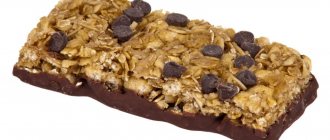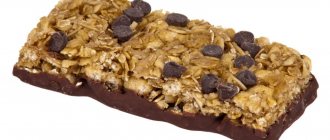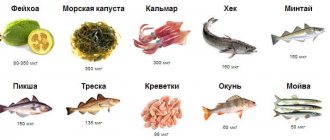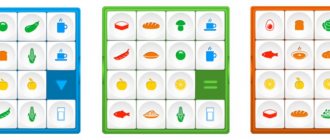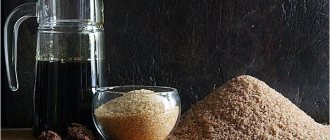Diabetes mellitus is a common disease that almost every adult has heard of. It can be congenital or acquired during life, but in any case it is chronic and cannot be completely cured. Many people have heard that diabetes is not a disease, but a way of life. After all, the patient must be on a special diet for life and use individually selected medications, and not always insulin injections. In general, nutrition for diabetes cannot be considered a diet in the widely accepted sense of the word, because there are not many restrictions in it, and most prohibited foods can be replaced with similar taste properties, but safe for the sensitive body of a diabetic.
What is diabetes mellitus and its types
Diabetes mellitus is a chronic disease in which there is a disturbance in glucose metabolism. It may be a consequence of a decrease in the amount of the hormone insulin produced by pancreatic cells, then type 1 diabetes mellitus (insulin-dependent) is diagnosed, or it can be the result of regular overeating, leading to obesity, severe stress and other factors, then type 2 diabetes mellitus (non-insulin-dependent) develops.
Insulin is a biologically active substance that is released into the blood, capturing a glucose molecule and transporting it to the desired cells.
It is type 2 diabetes that is most often diagnosed today and requires closer attention from doctors, as well as adherence to special nutritional principles, since it becomes a consequence of the unhealthy lifestyle that a person leads. With the regular intake of large amounts of carbohydrates into the body, the pancreas works for wear and tear and ultimately either ceases to cope with its function or produces “damaged” insulin, which cells and tissues do not perceive. This means that such insulin is not able to capture glucose and transport it to its destination, since the cells “do not see” it, i.e. Insensitivity to it develops. An important role in this is played by hormonal changes that inevitably occur with age.
In both cases, there will be a sharp increase in the concentration of glucose (sugar) in the blood and the development of characteristic symptoms:
- increased thirst;
- dry mouth;
- weakness;
- blurred vision;
- increased appetite, etc.
Type 2 diabetes mellitus is diagnosed most often, namely in 85-90% of patients. It usually occurs after 40 years of age, and especially often after 65 years of age. This vulnerability of older people to the development of carbohydrate metabolism disorders is a consequence of decreased physical activity and a decrease in muscle mass, which is the main consumer of glucose, and the increasingly observed abdominal obesity is becoming an additional factor that increases the risk of developing non-insulin-dependent diabetes.
Abdominal obesity is the predominant deposition of adipose tissue in the abdominal area.
Diagnosing diabetes is not difficult. To do this, a blood test is performed to check glucose levels. Obtaining increased indicators serves as a reason for further examination and selection of optimal treatment tactics, one of the mandatory components of which is nutritional correction.
Why is it important to follow basic nutritional principles?
With any type of diabetes, the blood sugar level increases, but despite this, the cells cannot receive it due to insulin deficiency or the development of immunity to it. Since glucose is a monosaccharide, which is a product of the breakdown of carbohydrates, it acts as the body's main source of energy. Therefore, if the tissues do not receive it in sufficient quantities, they experience hunger, which, due to the transmission of corresponding nerve impulses to the brain, leads to a similar feeling in humans. Therefore, with diabetes, patients may feel the urge to eat something, especially sweets, even an hour after a hearty lunch.
As a result, patients openly overeat high-calorie carbohydrate foods, which in type 2 diabetes quickly leads to weight gain and the progression of obesity. This leads to an even greater jump in blood glucose levels, increased load on the pancreas, increased insulin production, increased tissue resistance to it, and worsening of the condition, i.e., the formation of a vicious vicious circle.
In such situations, if the cycle is not intervened promptly, high sugar levels (hyperglycemia) will lead to the development of ketoacidosis and diabetic coma. Initially, the patient will experience extreme thirst and go to the toilet more often, then weakness, shortness of breath will quickly develop, a characteristic smell of acetone will appear from the mouth and urine, nausea and vomiting will occur. In the absence of competent medical care, confusion and ultimately diabetic coma will occur.
In addition, long-term uncontrolled diabetes mellitus (decompensated) can lead to the development of:
- retinal damage followed by irreversible blindness;
- impaired renal function and chronic renal failure;
- poorly healing trophic ulcers on the legs, which are very difficult to treat;
- osteoporosis, which is fraught with the possibility of breaking any of the bones of the skeleton, including the spine, even with a minor blow;
- disorders of the heart and blood vessels, gastrointestinal tract, etc.
Therefore, it is important not only to diagnose diabetes mellitus in a timely manner and take medications prescribed by an endocrinologist, but also to strictly follow nutritional recommendations.
Diet features
The diet for type 1 and type 2 diabetes mellitus has some differences that patients should understand. Regarding nutrition for insulin-dependent diabetes, in which patients receive lifelong replacement therapy in the form of regular insulin injections, doctors in different countries look at the need to limit simple carbohydrates differently.
Foreign endocrinologists believe that it is not necessary to reduce the amount of their consumption in type 1 diabetes with properly selected insulin therapy. Domestic doctors believe that this is fraught with undesirable consequences and insist on the need to limit the consumption of simple carbohydrates, but not completely abandon them, as in non-insulin-dependent diabetes. With type 2 diabetes mellitus, such disputes are not appropriate, since with it, consuming sugar can lead to disastrous consequences, which is not questioned in any country.
In addition, people with type 1 diabetes should be able to count bread units (BU), and people with type 2 diabetes should be able to determine the glycemic index (GI). Nutrition should be structured in such a way that these daily diet indicators meet the developed standards.
Therefore, today, patients with diabetes mellitus are prescribed the so-called diet No. 9 in various modifications, the differences between which are insignificant. The endocrinologist determines which table is most suitable for a particular patient, based on test results and the person’s condition.
In general, diet No. 9 is designed in such a way as to normalize carbohydrate metabolism by reducing the amount of simple carbohydrates consumed and, accordingly, reducing blood glucose levels. As a result, it is possible to bring the amount of sugar in the blood to normal, preventing the development of possible lipid metabolism disorders and complications of the disease.
Diet No. 9 involves a complete rejection of simple carbohydrates while consuming no more than 300 g of complex carbohydrates daily while maintaining the amount of protein food within the physiological norm.
Diet No. 9 for diabetes
The basic diet for type 2 diabetes mellitus is table No. 9 according to Pevzner. The main purpose of its purpose is to correct carbohydrate metabolism and prevent deviations in lipid and protein metabolism in the body against the background of elevated glucose levels.
The general characteristics of diet No. 9 look like this:
- Reducing the calorie content of food by reducing carbohydrates and lipids (fats) of animal origin;
- High content of vegetable fats and proteins;
- Elimination of sweets and sugar as the main sources of easily digestible carbohydrates;
- Limiting the use of kitchen salt and spices;
- Preference for boiled and stewed dishes instead of fried and smoked ones;
- Dishes should not be too hot or cold;
- Fractional and most importantly regular meals at the same time;
- Use of sweeteners: sorbitol and xylitol;
- Moderate fluid intake (daily amount 1300-1600 ml);
- Clear use of permitted foods and exclusion of prohibited ones, taking into account their glycemic index.
Find out more: How to lower blood sugar?
Basic principles of nutrition
For diabetes of any type, the following recommendations should be followed:
- meals must certainly be fractional and consist of at least 5 meals, especially in the insulin-dependent form;
- breakfast is a mandatory meal;
- when compiling a menu, you should adhere to the physiological ratio of proteins (meat, fish dishes, dairy products), carbohydrates (cereals, bread) and vegetables, they should account for 25%, 25% and 50%, respectively;
- advantage in nutrition is always given to products with a low glycemic index and a high percentage of plant fiber;
- Each meal starts with vegetables, and protein is left for the very end;
- the amount of salt should not exceed 5 g per day;
- fasting in diabetes is prohibited; if necessary, reduce weight by increasing physical activity;
- when choosing a method for preparing vegetables, it is recommended to give preference to minimal heat treatment or avoid it altogether; boiling, baking and steaming are ideal;
- A vegetarian diet for diabetes is not the best choice, although it helps improve the course of the disease and increase sensitivity to insulin; you can switch to it only with the permission of an endocrinologist.
Sugar-free diet: menu
The diet on a sugar-free diet should be carefully thought out and balanced:
Carbohydrates
- Complex carbohydrates (with a low glycemic index < 50IG) should make up 40-50% of the energy value of the diet (whole flour bread and pasta, cereals, brown rice, buckwheat and other grain products);
- Whole grains, vegetables, greens and unsweetened fruits;
- Simple carbohydrates (high glycemic index > 70IG) should be excluded from the diet as they contribute to a rapid increase in blood glucose levels;
- Make sure to provide your body with enough fiber (about 35 g/day).
Fats
- Fats should make up 25-35% of the energy value of the diet;
- Saturated fats are limited, they should make up 7-10% of all fats consumed;
- The cholesterol content in the daily diet should not exceed 300 mg/day;
- It is advisable to consume mono- and polyunsaturated fats, including: unrefined cold-pressed oils: rapeseed, flaxseed, buckwheat, olive. Fish, avocados, seeds and nuts are also good sources of unsaturated fats.
Squirrels
- Should constitute 15-20% of the energy value of the diet;
- Foods that contain good quality protein include: low-fat dairy, fish, seeds, legumes and poultry.
Nutrition for type 1 diabetes mellitus - table
Insulin-dependent diabetes is usually diagnosed in childhood. Since the cause of its development is the destruction of insulin-synthesizing pancreatic cells, patients are necessarily prescribed insulin therapy, and the drug and dosage are selected individually. Insulin injections completely cover the deficiency of hormone production in the body, so significant dietary restrictions are not required, but the child’s parents, and then the child himself, must learn to correctly calculate the amount of carbohydrates consumed so that it corresponds to the dose of insulin administered. For this purpose, tables have been specially created indicating the number of so-called bread units in each product.
For type 1 diabetes, you only need to avoid:
- any sweet drinks, including juices;
- ready-made breakfast cereals;
- confectionery products.
You can eat no more than 7 XE per meal, and up to 25 XE per day. In this case, the amount of all carbohydrates eaten in terms of serving size is summed up. For example, 2 XE is contained in 3 tbsp. l. prepared pasta, 4 tbsp. l. rice, 14 tbsp. l. legumes or 420 g tomatoes.
1 XE is equal to 12 g of carbohydrates or 20 g of bread.
Sweets are not strictly prohibited, but only those who monitor their blood glucose levels several times a day, accurately count XE and can independently regulate the dose of insulin administered can afford them.
In severe forms of type 1 diabetes, patients are prescribed diet No. 9b and large doses of insulin. It involves consuming 400-450 g of carbohydrates and is very close to the diet of most modern people. You are allowed to consume 20-30 g of sugar daily.
The endocrinologist monitoring the patient’s condition will definitely tell you how to distribute the amount of food between individual meals, depending on what type of drug he prescribed. So, when administering insulin twice a day (morning and afternoon), it is necessary to create a menu so that almost 2/3 of the total daily carbohydrate intake occurs at this time. Moreover, after each injection you need to eat 2 times - 15 minutes after the injection and 3 hours after that. Fractional nutrition and control of the amount of XE is the basis of the diet for type 1 diabetes.
If after the injection the patient suddenly feels weak, this indicates a deficiency of glucose in the body. In such situations, you should immediately eat a piece of dark chocolate.
Thus, with the insulin-dependent form of the disease, the main difficulty lies in the need to control not the type of food, but its volume and count bread units.
Nutrition for type 2 diabetes mellitus
In most cases, the main cause of the disease is obesity. Therefore, diet for type 2 diabetes is the first and main component of treatment and prevention of complications. With its help, it will be possible to normalize sugar levels and control weight, thereby preventing the occurrence of unwanted changes and deterioration of the condition.
All patients need to independently monitor their blood glucose levels daily using household glucometers, and if they consistently receive high levels, immediately contact their doctor.
If a patient is diagnosed with a non-insulin-dependent form of the disease, mild or moderate, and his weight is within the normal range, he is prescribed basic diet No. 9 with a daily calorie content of up to 2500 kcal. In such situations, you can consume no more than 275-300 g of complex carbohydrates per day from various sources.
In the presence of obesity, it is necessary not only to maintain glucose levels within normal limits, but also to reduce weight, since its excess negatively affects the effectiveness of treatment and the well-being of patients. Therefore, in such cases, patients are prescribed the so-called reduced diet No. 9, which is characterized by a reduced calorie content due to an even greater limitation of the permissible amount of complex carbohydrates consumed daily. In this case, the endocrinologist individually calculates this norm based on the degree of obesity. Therefore, in different cases, patients may be allowed to consume from 100 to 225 g of carbohydrates, and the total caloric content of the diet should not exceed 1700 kcal per day.
What not to do
So, with type 2 diabetes mellitus, it is necessary to completely exclude from the diet foods containing so-called fast carbohydrates, i.e. those that are broken down into glucose and absorbed into the blood within 15 minutes. They quickly give a boost of energy, but do not create a feeling of fullness, so after eating them, hunger returns very quickly. These include:
- sugar;
- honey;
- confectionery, classic pastries;
- ice cream, chocolate;
- marmalade, jam, marmalade, preserves;
- sweet vegetables, fruits, berries (grapes, bananas, dates, pineapple, persimmons, dried fruits);
- white bread, loaf;
- semolina;
- smoked meats, fatty foods;
- mayonnaise;
- fast food, snacks.
Special recipes have been created for diabetics, including approved products for baking.
Diet No. 9 does not require complete refusal, but recommends reducing the amount consumed as much as possible:
- potatoes;
- beets;
- corn;
- carrots;
- soy products;
- pasta;
- of bread.
If you are obese, you will need to completely avoid all foods high in fat:
- butter and vegetable oil, spreads;
- sour cream, fatty cheeses, cottage cheese, cream;
- lard, fatty meat and fish, chicken with skin;
- nuts, seeds;
- alcohol, etc.
In such situations, it is recommended to replace these foods with vegetables that have a beneficial effect on carbohydrate metabolism. These are leafy greens, eggplants, cucumbers, turnips, cauliflower, pumpkin, zucchini, radishes, etc.
You should definitely try to completely avoid foods with a lot of fat, in particular canned food, meat processing products, and store-bought sauces. They are replaced with boiled or stewed dietary meat (chicken, rabbit, turkey, low-fat yogurt without additives).
What is possible
Carbohydrates are an essential part of the daily diet, and they must be present on the menu for diabetes, but only in acceptable quantities. Patients are allowed to eat only foods with slowly absorbed carbohydrates and a high content of dietary fiber. This:
- vegetables;
- coarse bread, whole grain, with bran;
- whole grain cereals (8-10 tbsp), with the exception of refined rice.
Since sugar in any form is prohibited for diabetics, its substitutes that do not contain glucose were specially created. Many of them are many times sweeter than sugar and can be used in minimal quantities. Modern sweeteners include: xylitol, stevia, sorbitol, fructose. But studies have shown that some of them can have a negative effect on the body. Stevia is considered the safest sweetener today. It is obtained from natural raw materials, and its sweetness is 10-30 times higher than sugar (depending on the form of release: grass powder or an extract called stevioside).
It is important for patients to know the glycemic index of foods. Today there are special tables that help you navigate your choice and correctly calculate the permissible consumption rate. For diabetes, preference should be given to foods with a GI of less than 55 (apples, cucumbers, cherries, broccoli, lettuce, milk, cauliflower, etc.). They break down slowly and practically do not lead to an increase in blood sugar levels. You can eat up to 200 g of such products per meal, but preferably together with protein foods.
Heat treatment increases GI.
Allowed to use:
- potatoes (no more than 200 g per day);
- dishes with meat and vegetable broth;
- lean varieties of meat and fish (chicken, turkey, pollock, pike, hake);
- lentils;
- low-fat fermented milk and dairy products, cheeses with a fat content of less than 30%;
- eggs (3-4 per week, but not more than 1 per day);
- vegetable oil (no more than 1 tbsp per day);
- special candies, waffles, breads for diabetics.
When preparing homemade compotes, sweeteners are added instead of sugar.
Allowed foods for diabetes
It is advisable to replace quickly digestible carbohydrates with raw, boiled and baked vegetables, which are very useful for diabetes. Food should contain increased amounts of vitamins, which is of great importance for any disease.
Since the diet for diabetes is aimed not only at normalizing carbohydrate metabolism, but also at preventing disruptions in fat metabolism (in the liver), it is necessary to consume foods with large amounts of lipotropic substances. Sugar and sweets are excluded due to the risk of developing hyperglycemic coma. Preference should be given to complex carbohydrates, which are slowly broken down in the stomach, while simple ones begin to be absorbed in the mouth.
The list of permitted products includes:
- bran and rye bread - about 200-300 grams;
- lean varieties of beef, veal, pork and lamb (cut off all fat);
- poultry (turkey, skinless chicken) boiled or stewed;
- rabbit meat;
- boiled tongue, dietary sausage;
- boiled or baked low-fat fish;
- canned fish in its own juice;
- boiled eggs, white omelettes - no more than 2 eggs per day, yolk - 1 time per week;
- vegetable soups, weak meat broths;
- milk at the doctor’s discretion (one glass per day), low-fat cottage cheese, kefir, low-fat fermented baked milk;
- unsalted and mild cheese;
- butter and ghee without salt;
- porridge from buckwheat, millet, pearl barley, oatmeal;
- limited pasta and legumes;
- sour berries and fruits;
- vegetables (limited potatoes, white and cauliflower cabbage, zucchini, eggplant) boiled and baked;
- jelly, jelly, mousse;
- weak tea or coffee with milk, compotes and fruit drinks without sugar;
- jellied fish, vegetable caviar, vinaigrette, soaked herring;
- vegetable oil for salads;
- okroshka.
Nutrition for gestational diabetes
Pregnant women with a genetic predisposition to developing diabetes may experience the development of so-called gestational diabetes at 20-24 weeks. It occurs against the background of hereditary reduced sensitivity of tissues to inulin, which increases under the influence of hormones produced during pregnancy in increased quantities: estrogen, prolactin, cortisol. They are able to block insulin and cause an increase in blood sugar levels.
Often after childbirth, carbohydrate metabolism gradually returns to normal as hormonal levels normalize. But still, if the basic principles of nutrition and diet are not followed, there is not only a risk of maintaining diabetes mellitus, but also the development of complications that can lead to premature birth, pyelonephritis in the mother, pathologies of the fundus, as well as complications during childbirth. It is for the purpose of timely detection of gestational diabetes during pregnancy that blood glucose levels are regularly tested, and if hyperglycemia is detected, a diet is prescribed.
In such situations, women are recommended to:
- completely eliminate simple carbohydrates from the diet (the same sugar, confectionery, chocolate, pastries, white and brown bread, bananas, grapes, juices, dried fruits, etc.);
- limit your intake of complex carbohydrates to the amounts recommended by your doctor;
- devote most of the daily diet to vegetables and unsweetened fruits;
- Avoid eating fatty foods, fried foods, processed foods, a variety of sausages, and smoked foods;
- when choosing a method of preparing food, give preference to baking, stewing, and steaming;
- eat in small portions, preferably every 2 hours, highlighting 3 main meals (breakfast, lunch and dinner), as well as 2 additional ones (second breakfast, afternoon snack);
- drink at least 1.5 liters of water.
Pregnant women with gestational diabetes are advised to measure their blood sugar levels after each meal.
All these recommendations are also relevant for the postpartum period. In any case, in the first months of a baby’s life, a woman who is breastfeeding is forced to follow a hypoallergenic diet and give up fried, fatty foods. The same diet will help eliminate gestational diabetes and avoid its transition to a chronic disorder of carbohydrate metabolism within 2-3 months after childbirth. If, after this period of time, the blood glucose level does not normalize, the woman needs to contact an endocrinologist to undergo an examination and develop treatment tactics.
Sugar-lowering products
There are a number of foods that help lower blood glucose levels. They are called hypoglycemic and are recommended for use by patients with diabetes. But since each person is a unique biological system and has individual characteristics, he can react to certain types of products in his own way, and not only give allergic reactions. Therefore, although sugar-lowering products can provide invaluable assistance to patients with diabetes, especially type 2, it is worth consulting an endocrinologist before starting their daily use.
So, sugar-lowering products include:
- Cherry (GI 22) – contains anthocyanin, which helps lower sugar levels and blood pressure, eliminating the so-called bad cholesterol. The daily norm is 100 g.
- Grapefruit (GI 29) – contains naringin, which is a powerful antioxidant and helps increase tissue sensitivity to insulin. It is recommended to consume 1 medium-sized grapefruit or freshly squeezed juice per day (industrial juice is not suitable). But grapefruit can negatively affect the quality of absorption of various medications, so consultation with your doctor before including it in the menu is mandatory.
- Cinnamon is a source of polyphenols that help keep sugar levels under control. The daily norm is 1/2 teaspoon. It can be added to cottage cheese, oatmeal, and is very suitable for making casseroles with apples.
- Broccoli is a valuable source of fiber, which is so beneficial for diabetes, and the substances it contains help slow down the rate of sugar absorption in the intestines. Daily norm – 200 g.
- Blueberries are one of the healthiest foods for diabetics, as they contain valuable glycosides, tannins, and anthocyanins, which help maintain normal glucose levels and reduce the risk of developing diabetic retinal damage. Daily norm – 200 g.
- Oatmeal and millet porridges contain a large amount of fiber, which helps maintain normal sugar levels.
- Jerusalem artichoke is a natural source of insulin, due to which its use helps normalize glucose levels, and the presence of fructose in the composition provides a pleasant sweet taste, which allows it to be used raw or added to salads.
- Garlic is one of the healthiest foods for every person, as it contains many antioxidants, natural antibacterial and other substances. Its use causes the pancreas to work more actively, which is very valuable for patients with type 1 diabetes.
- Fish – diabetics are advised to eat fish at least 2 times a week, and if possible they try to replace meat dishes with it. This helps normalize sugar levels and also provide essential polyunsaturated fatty acids.
Thus, nutrition for diabetes can be varied and tasty. With a competent approach to menu planning, it will not cause rejection, but on the contrary will help increase energy and performance, since it largely corresponds to the principles of rational nutrition. But remember, if you have diabetes, it is important to maintain a normal level of physical activity, since exercise increases the sensitivity of tissues to insulin.
What do you eat if you have diabetes?
The very first concern of most diabetic patients is to ask the doctor about foods that can be consumed daily. It is necessary to focus on vegetables, fruits, meat and dairy products. After all, if you exclude the use of glucose as the main source of fast energy, this will lead to rapid depletion of the body’s natural reserves of energy substances (glycogen) and protein breakdown. To prevent this from happening, the diet must contain a sufficient amount of protein foods, vitamins and microelements.
Beans for diabetes
It is one of the most powerful sources of these substances. Therefore, the main emphasis should be placed on it as the main donor of protein and amino acid components. It is especially worth noting the healing properties of white beans. Many diabetics are very indifferent to it, because they do not know how many interesting dishes can be prepared from this product. They will turn out to be not only healthy, but also tasty. The only limitation for eating beans is their ability to produce powerful gases in the intestines. Therefore, if a person has a similar tendency, it is better to use beans as a nutritious product on a limited basis or combine them with taking enzyme preparations, which will almost completely eliminate gas formation.
Regarding the amino acid composition of beans, its most valuable components are tryptophan, valine, methionine, lysine, threonine, leucine, phenylalanine, histidine. Some of these amino acids are essential (those that are not synthesized in the body and must be supplied with food). Among microelements, vitamins C, B, PP, zinc, potassium, phosphorus and iron are of primary importance. All of them are very important for the normal functioning of the body in conditions of elevated blood glucose levels. Beans also have a positive effect on carbohydrate metabolism, since these compounds are represented mainly by fructose and sucrose.
Porridge for diabetes
The most important place in a diabetic's diet belongs to buckwheat. It is consumed in the form of milk porridge or as a component of a second course. The peculiarity of buckwheat is that it has virtually no effect on carbohydrate metabolism, since it maintains glucose levels at a constant level, and does not cause its sudden rise, as happens when consuming most foods.
Other porridges that are recommended for diabetes are oatmeal, wheat, corn and pearl barley. In addition to the rich vitamin composition, they are very easily digestible and are treated with digestive enzymes. As a result, a positive effect on carbohydrate metabolism with normalization of glycemic levels. In addition, they are a good energy substrate and an essential source of ATP for cells.
What fruits can you eat if you have diabetes?
This group of foods should have a special place in diabetes. After all, fruits contain the most fiber, vital vitamins and minerals. Their concentration is several times higher than that in other food products. Carbohydrates are represented mainly by fructose and sucrose; they contain virtually no glucose.
As for specific fruits that are recommended to be consumed for diabetes, it is worth pointing out the special value of only some of them. After all, not everything is allowed to be consumed. Favorite fruits for diabetics include grapefruit, lemon, orange, apples, apricots and peaches, pears, pomegranate, dried fruits (dried apricots, prunes, dried apples), berries (cherries, gooseberries, blueberries, all types of currants, blackberries). Watermelon and sweet melon contain slightly more carbohydrate components and should be consumed in moderation.
Tangerines, grapefruit and lemon
This is the set of fruits that every diabetic should focus on.
Firstly, they are all very rich in vitamin C. This compound is one of the most important in the functioning of enzyme systems and strengthening the vascular wall.
Secondly, all citrus fruits have a very low glycemic index. This means that the content of carbohydrate components in them, which affect blood glucose levels, is very low.
Their third advantage is the presence of strong antioxidant abilities, which prevents the negative effect of hyperglycemia on the body's cells, slowing down the progression of diabetes complications.
Regarding tangerines, there are small notes for their consumption. First of all, the fruits must be fresh. They are consumed raw or freshly prepared from them. It is better not to buy juices, especially in regular stores, as they contain sugar and other carbohydrate components that can increase glycemic levels. Lemon and grapefruit are also consumed as a separate product or freshly squeezed juice, which is added to water or other foods.
Read more: 16 best foods for diabetes

